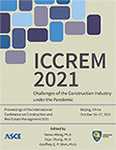Research on Operation Efficiency of Beijing Rail Transit Based on DEA-Malmquist Index
Publication: ICCREM 2021
ABSTRACT
The investment amount of urban rail transit project is huge, which undertakes the important urban public service function, and its operation efficiency is worthy of attention. In this paper, DEA-Malmquist index is used to measure and analyze the operation efficiency and its change of 17 lines in Beijing from 2015 to 2019. The results show that: most of the lines are in the stage of increasing returns to scale, the overall operational efficiency is on the rise, and the technical efficiency change is the main driving factor for the improvement of comprehensive efficiency. Combined with the projection of decision making unit (DMU) on the production frontier, the input indexes of DMUs with invalid scale are redundant and need further improvement. In the future, it will deeply analyze the causes of operational efficiency differences and put forward development suggestions for the sustainable supply and operation of infrastructure.
Get full access to this article
View all available purchase options and get full access to this chapter.
REFERENCES
Banker, R. D., Abraham, C., and Cooper, W. W. (1984). “Some models for estimating technical and scale inefficiencies in data envelopment analysis.” Management Science, 30(9), 1078–1092.
Caves, D. W., Christensen, L. R., and Diewert, W. E. (1982). “The eco-nomic theory of index numbers and the measurement of input, output, and productivity.” Econometric, 50(6), 1393–1414.
Cooper, W. W. (2002). “A brief history of a long collaboration in developing industrial uses of linear programming.” Operations Research, 50(1), 35–41.
Färe, R., Grosskopf, S., and Norris, M. (1997). “Productivity growth, technical progress, and efficiency change in industrialized countries: reply.” The American Economic Review, 87(5), 1040–1044.
Hou, X. F., Mei, J. P., Zuo, C., and Liu, G. Y. (2020). “Statistical analysis of urban rail transit lines in 2019.” Urban rapid Rail Transit, 33(04), 1–8. (in Chinese).
Li, L., and Yao, X. Y. (2015). “Efficiency of urban rail transit industry based on DEA and Malmquist index.” Journal of Jiangnan University (Natural Science Edition), 14(01), 103–109. (in Chinese).
Malmquist, S. (1953). “Index numbers and indifference surfaces.” Trabajos De Estadistica, 4(2), 209–242.
Zhang, H., and You, J. X. (2018). “Transportation efficiency of urban rail transit based on DEA and Tobin model.” Journal of Tongji University (Natural Science Edition), 46 (09), 1306–1311. (in Chinese).
Zhou, Q., Qin, F. F., and Wu, G. (2014). “Efficiency evaluation of urban rail transit system based on DEA method.” Railway Transportation and Economy, 36(02), 79–83. (in Chinese).
Information & Authors
Information
Published In
Copyright
© 2021 American Society of Civil Engineers.
History
Published online: Dec 9, 2021
Authors
Metrics & Citations
Metrics
Citations
Download citation
If you have the appropriate software installed, you can download article citation data to the citation manager of your choice. Simply select your manager software from the list below and click Download.
